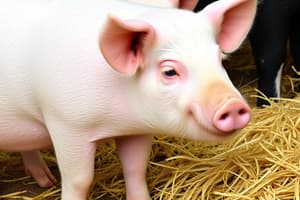Podcast
Questions and Answers
What is the primary purpose of the 28-Hour Law in swine transportation?
What is the primary purpose of the 28-Hour Law in swine transportation?
- To dictate the size and breed of pigs that can be transported
- To ensure proper ventilation in trailers
- To provide regular rest stops for animals during transportation (correct)
- To regulate the handling of pigs during loading and unloading
What is a key principle of proper pig handling techniques during transportation?
What is a key principle of proper pig handling techniques during transportation?
- Using loud noises to encourage pigs to move
- Approaching pigs calmly and quietly to avoid startling them (correct)
- Moving pigs quickly to reduce transportation time
- Handling pigs individually to reduce stress
What is an essential feature of swine transport trailers?
What is an essential feature of swine transport trailers?
- A ventilation system to maintain airflow and temperature control (correct)
- A built-in feeding system
- A weighing scale to measure pig weight
- A system to monitor pig behavior
Why is it important to handle pigs in small groups during transportation?
Why is it important to handle pigs in small groups during transportation?
What is a critical aspect of maintaining pig health and safety during transportation?
What is a critical aspect of maintaining pig health and safety during transportation?
What is the purpose of pig boards or guidance tools during transportation?
What is the purpose of pig boards or guidance tools during transportation?
Study Notes
Swine Transportation Regulations
- In the United States, swine transportation is regulated by the Animal Welfare Act (AWA) and the 28-Hour Law
- The AWA sets standards for the humane treatment of animals during transportation
- The 28-Hour Law requires trucks to stop every 28 hours to allow animals to rest, eat, and drink
- Transporters must also comply with state and local regulations
Pig Handling Techniques
- Proper handling techniques are crucial to reduce stress and injury to pigs during transportation
- Handlers should approach pigs calmly and quietly to avoid startling them
- Pigs should be moved slowly and gently to prevent bruising and injury
- Handlers should use pig boards or other guidance tools to direct pigs onto and off of trailers
- Pigs should be handled in small groups to reduce stress and aggression
Trailer Design
- Trailer design plays a critical role in swine transportation
- Key features of swine transport trailers include:
- Ventilation systems to maintain airflow and temperature control
- Flooring and bedding to provide comfort and traction
- Divided compartments to separate pigs and reduce aggression
- Ramps and gates designed for easy loading and unloading
- Sanitation systems to reduce disease transmission
- Trailers should be designed to accommodate different pig sizes and breeds
- Regular maintenance and cleaning of trailers are essential to ensure pig health and safety
Swine Transportation Regulations
- Regulated by the Animal Welfare Act (AWA) and the 28-Hour Law in the United States
- AWA sets standards for humane treatment of animals during transportation
- 28-Hour Law requires trucks to stop every 28 hours for animal rest, eating, and drinking
- Transporters must comply with state and local regulations
Pig Handling Techniques
- Proper handling reduces stress and injury to pigs during transportation
- Handlers should approach pigs calmly and quietly to avoid startling
- Pigs should be moved slowly and gently to prevent bruising and injury
- Pig boards or guidance tools should be used to direct pigs onto and off of trailers
- Handling in small groups reduces stress and aggression
Trailer Design and Maintenance
- Trailer design is critical to swine transportation
- Key features of swine transport trailers:
- Ventilation systems for airflow and temperature control
- Flooring and bedding for comfort and traction
- Divided compartments to separate pigs and reduce aggression
- Ramps and gates designed for easy loading and unloading
- Sanitation systems to reduce disease transmission
- Trailers should accommodate different pig sizes and breeds
- Regular trailer maintenance and cleaning are essential for pig health and safety
Studying That Suits You
Use AI to generate personalized quizzes and flashcards to suit your learning preferences.
Description
Learn about the regulations and techniques for transporting and handling swine in the United States, including the Animal Welfare Act and the 28-Hour Law.




